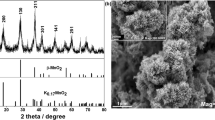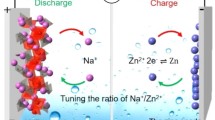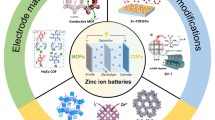Abstract
Aqueous potassium-based batteries (APBs) have been widely studied for their high safety and environmentally friendly properties. However, given the limitation of the electrode material and working mechanism, the APBs need further improvement in terms of the rate performance and energy density to meet the development requirements. To address the above issues, we successfully designed and assembled APBs, for the first time using Zn metal as the anode, K1.92Cu0.62Mn0.38[Fe(CN)6]0.968·□0.032·0.35H2O as the cathode, and 2 mol L−1 Zn(SO3CF3)2 + 12 mol L−1 KSO3CF3 as the electrolyte. This hybrid-ion-battery (HIB) design offers benefits including the following: (i) improvement of the working potential of APBs by selecting Zn metal as the anode, (ii) shortened ion transport path due to the dual-cation storage mechanism, and (iii) inhibition of the growth of zinc dendrite through the electrostatic shielding effect enabled by K+, which originated from the dual-cation electrolyte. As a result, the as-assembled full battery had a high working potential of 1.75 V and excellent rate performance (83.3% of original capacity was maintained at the current density of 10,000 mA g−1). Furthermore, the in-situ electrostatic shielding effect, which can significantly inhibit the dendrite growth of the Zn anode and improve the stability of the full battery, was fully revealed by theoretical phase-field simulation and comprehensive characterizations. The fascinating structure design of HIBs sheds light on the development of high-performance APBs.

摘要
水系钾基电池(APBs)因具有高安全性和环境友好的性质而被广泛研究. 然而, 由于电极材料和工作机制的限制, APBs在倍率性能和能量密度方面需要进一步提高, 以满足发展需求. 针对上述问题, 我们首次成功设计并组装了以Zn金属作为阳极, K1.92Cu0.62Mn0.38−[Fe(CN)6]0.968·□0.032·H2O0.35作为阴极, 2 mol L−1 Zn(SO3CF3)2 + 12 mol L−1 KSO3CF3作为电解液的水系钾基电池. 这种混合离子体系的设计优点是: (i) 选择金属锌作为阳极, 提高了APBs的工作电位; (ii) 双阳离子储存机制缩短了离子传输路径; (iii) 来自双阳离子电解质的K+通过静电屏蔽作用抑制了锌枝晶的生长. 因此, 组装后的全电池具有1.75 V的高工作电位, 并具有优异的倍率性能(在10,000 mA g−1的电流密度下, 保持原有容量的83.3%). 此外, 通过理论相场模拟和综合表征充分揭示了原位静电屏蔽效应, 显著抑制了锌阳极的枝晶生长, 提高了全电池稳定性. 混合离子电池的结构设计为高性能APBs的发展提供了思路.
Similar content being viewed by others
References
Ge J, Fan L, Rao AM, et al. Surface-substituted Prussian blue analogue cathode for sustainable potassium-ion batteries. Nat Sustain, 2021, 5: 225–234
Luo W, Feng Y, Shen D, et al. Engineering ion diffusion by CoS@SnS heterojunction for ultrahigh-rate and stable potassium batteries. ACS Appl Mater Interfaces, 2022, 14: 16379–16385
Zhang X, Zhang S, Yang Y, et al. A general method for transition metal single atoms anchored on honeycomb-like nitrogen-doped carbon nanosheets. Adv Mater, 2020, 32: 1906905
Li Y, Lin S, Wang D, et al. Single atom array mimic on ultrathin MOF nanosheets boosts the safety and life of lithium-sulfur batteries. Adv Mater, 2020, 32: 1906722
Yang W, Zhou J, Wang S, et al. Freestanding film made by necklace-like N-doped hollow carbon with hierarchical pores for high-performance potassium-ion storage. Energy Environ Sci, 2019, 12: 1605–1612
Tang F, Guo S, Sun Y, et al. Facile synthesis of Fe-doped CoO nanotubes as high-efficient electrocatalysts for oxygen evolution reaction. Small Struct, 2022, 3: 2100211
Piao J, Bin D, Duan S, et al. A facile template free synthesis of porous carbon nanospheres with high capacitive performance. Sci China Chem, 2018, 61: 538–544
Lei K, Wang C, Liu L, et al. A porous network of bismuth used as the anode material for high-energy-density potassium-ion batteries. Angew Chem Int Ed, 2018, 57: 4687–4691
Hu Y, Fan L, Rao AM, et al. Cyclic-anion salt for high-voltage stable potassium-metal batteries. Natl Sci Rev, 2022, nwac134
Yu W, Wang J, Wang Z, et al. Pegylation of the antimicrobial peptide PG-1: A link between propensity for nanostructuring and capacity of the antitrypsin hydrolytic ability. J Med Chem, 2021, 64: 10469–10481
Ye S, Wang L, Liu F, et al. Integration of homogeneous and heterogeneous nucleation growth via 3D alloy framework for stable Na/K metal anode. eScience, 2021, 1: 75–82
Lei K, Zhu Z, Yin Z, et al. Dual interphase layers in situ formed on a manganese-based oxide cathode enable stable potassium storage. Chem, 2019, 5: 3220–3231
Liu Z, Yang Y, Liang S, et al. pH-buffer contained electrolyte for self-adjusted cathode-free Zn−MnO2 batteries with coexistence of dual mechanisms. Small Struct, 2021, 2: 2100119
Zeng X, Xie K, Liu S, et al. Bio-inspired design of an in situ multifunctional polymeric solid-electrolyte interphase for Zn metal anode cycling at 30 mA cm−2 and 30 mA h cm−2. Energy Environ Sci, 2021, 14: 5947–5957
Liu S, Mao J, Pang WK, et al. Tuning the electrolyte solvation structure to suppress cathode dissolution, water reactivity, and Zn dendrite growth in zinc-ion batteries. Adv Funct Mater, 2021, 31: 2104281
Zhang S, Liu Y, Fan Q, et al. Liquid metal batteries for future energy storage. Energy Environ Sci, 2021, 14: 4177–4202
Qin L, Zhang S, Zheng J, et al. Pursuing graphite-based K-ion O2 batteries: A lesson from Li-ion batteries. Energy Environ Sci, 2020, 13: 3656–3662
Cao AM, Hu JS, Wan LJ. Morphology control and shape evolution in 3D hierarchical superstructures. Sci China Chem, 2012, 55: 2249–2256
Tan H, Zhou Y, Qiao SZ, et al. Metal organic framework (MOF) in aqueous energy devices. Mater Today, 2021, 48: 270–284
Yu W, Liu Z, Yu X, et al. Balsa-wood-derived binder-free freestanding carbon foam as high-performance potassium anode. Adv Energy Sustain Res, 2021, 2: 2100018
Ren X, Zhao Q, McCulloch WD, et al. MoS2 as a long-life host material for potassium ion intercalation. Nano Res, 2017, 10: 1313–1321
Lei Y, Han D, Dong J, et al. Unveiling the influence of electrode/electrolyte interface on the capacity fading for typical graphite-based potassium-ion batteries. Energy Storage Mater, 2020, 24: 319–328
Jiang L, Lu Y, Zhao C, et al. Building aqueous K-ion batteries for energy storage. Nat Energy, 2019, 4: 495–503
Su D, McDonagh A, Qiao SZ, et al. High-capacity aqueous potassium-ion batteries for large-scale energy storage. Adv Mater, 2017, 29: 1604007
Shen D, Rao AM, Zhou J, et al. High-potential cathodes with nitrogen active centres for quasi-solid proton-ion batteries. Angew Chem Int Ed, 2022, 61: e202201972
Cheng N, Xu P, Lu B, et al. Covalent sulfur as stable anode for potassium ion battery. J Energy Chem, 2021, 62: 645–652
Li F, Wu S, Li D, et al. The water catalysis at oxygen cathodes of lithium-oxygen cells. Nat Commun, 2015, 6: 7843
Sun T, Li ZJ, Zhi YF, et al. Poly(2,5-dihydroxy-1,4-benzoquinonyl sulfide) as an efficient cathode for high-performance aqueous zinc-organic batteries. Adv Funct Mater, 2021, 31: 2010049
Chen S, Kuang Q, Fan HJ. Dual-carbon batteries: Materials and mechanism. Small, 2020, 16: 2002803
Wu L, Gu M, Feng Y, et al. Layered superconductor Cu0.11TiSe2 as a high-stable K-cathode. Adv Funct Mater, 2022, 32: 2109893
Liu Z, Wang J, Lu B. Plum pudding model inspired KVPO4F@3DC as high-voltage and hyperstable cathode for potassium ion batteries. Sci Bull, 2020, 65: 1242–1251
You Y, Yao HR, Xin S, et al. Subzero-temperature cathode for a sodium-ion battery. Adv Mater, 2016, 28: 7243–7248
Gebert F, Cortie DL, Bouwer JC, et al. Epitaxial nickel ferrocyanide stabilizes Jahn-Teller distortions of manganese ferrocyanide for sodium-ion batteries. Angew Chem Int Ed, 2021, 60: 18519–18526
Li WJ, Chou SL, Wang JZ, et al. Multifunctional conducing polymer coated Na1+xMnFe(CN)6 cathode for sodium-ion batteries with superior performance via a facile and one-step chemistry approach. Nano Energy, 2015, 13: 200–207
Wessells CD, Huggins RA, Cui Y. Copper hexacyanoferrate battery electrodes with long cycle life and high power. Nat Commun, 2011, 2: 550
Fan L, Ma R, Wang J, et al. An ultrafast and highly stable potassium-organic battery. Adv Mater, 2018, 30: 1805486
Fan X, Gaddam RR, Kumar NA, et al. A hybrid Mg2+/Li+ battery based on interlayer-expanded MoS2/graphene cathode. Adv Energy Mater, 2017, 7: 1700317
Zhu Y, Yin J, Zheng X, et al. Concentrated dual-cation electrolyte strategy for aqueous zinc-ion batteries. Energy Environ Sci, 2021, 14: 4463–4473
Deng L, Qu J, Niu X, et al. Defect-free potassium manganese hexacyanoferrate cathode material for high-performance potassium-ion batteries. Nat Commun, 2021, 12: 2167
Gao C, Liu Y, Zheng L, et al. The effect of electrolyte type on the Li ion intercalation in copper hexacyanoferrate. J Electrochem Soc, 2019, 166: A1732–A1737
Bie X, Kubota K, Hosaka T, et al. Synthesis and electrochemical properties of Na-rich Prussian blue analogues containing Mn, Fe, Co, and Fe for Na-ion batteries. J Power Sources, 2018, 378: 322–330
Ma X, Cao X, Yao M, et al. Organic-inorganic hybrid cathode with dual energy-storage mechanism for ultrahigh-rate and ultralong-life aqueous zinc-ion batteries. Adv Mater, 2022, 34: 2105452
Yu Z, Cao L, Liu H, et al. High voltage aqueous Zn/LiCoO2 hybrid battery under mildly alkaline conditions. Energy Storage Mater, 2021, 43: 158–164
Eftekhari A, Jian Z, Ji X. Potassium secondary batteries. ACS Appl Mater Interfaces, 2017, 9: 4404–4419
Ling T, Da P, Zheng X, et al. Atomic-level structure engineering of metal oxides for high-rate oxygen intercalation pseudocapacitance. Sci Adv, 2018, 4: eaau6261
Wessells CD, Peddada SV, Huggins RA, et al. Nickel hexacyanoferrate nanoparticle electrodes for aqueous sodium and potassium ion batteries. Nano Lett, 2011, 11: 5421–5425
Wu XY, Sun MY, Shen YF, et al. Energetic aqueous rechargeable sodium-ion battery based on Na2CuFe(CN)6−NaTi2(PO4)3 intercalation chemistry. ChemSusChem, 2014, 7: 407–411
Acknowledgements
This work was financially supported by the National Natural Science Foundation of China (U20A20247 and 51922038).
Author information
Authors and Affiliations
Contributions
Author contributions Yu W and Ge J conducted the experiment; Wu L and Luo W did some characterizations. Lu B, Hu Y, Shen D and Chen S performed some data analysis and offered helpful suggestions. Liu Z, Zhou J and Yang H designed this study. All authors contributed to the general discussion.
Corresponding authors
Ethics declarations
Conflict of interest The authors declare that they have no conflict of interest.
Additional information
Supplementary information Supporting data are available in the online version of the paper.
Weijian Yu received his BSc and master degrees in electronic science and technology from Hunan University (HNU) in 2019. He is currently a doctoral candidate at Harbin Institute of Technology (HIT). His research interests focus on the modification of electrolytes for Li/Na/Zn-ion batteries.
Junmin Ge received his doctorate degree from the Department of Physics and Electronics, HNU in 2021. He is currently a researcher at Zhengzhou University. His research interests focus on noval high-safety energy storage batteries.
Bingan Lu is a professor and doctoral supervisor at HNU. Prof. Lu’s research mainly focuses on the research of new energy storage materials and devices including Li/K/Al-ion batteries. He is on the Editorial Board or Youth Editorial Board of National Science Review, Molecules, Science China Technological Sciences, InfoMat, and SmartMat.
Supplementary Information
Rights and permissions
About this article
Cite this article
Yu, W., Ge, J., Hu, Y. et al. Hybrid high-performance aqueous batteries with potassium-based cathode||zinc metal anode. Sci. China Mater. 66, 923–931 (2023). https://doi.org/10.1007/s40843-022-2213-y
Received:
Accepted:
Published:
Issue Date:
DOI: https://doi.org/10.1007/s40843-022-2213-y




